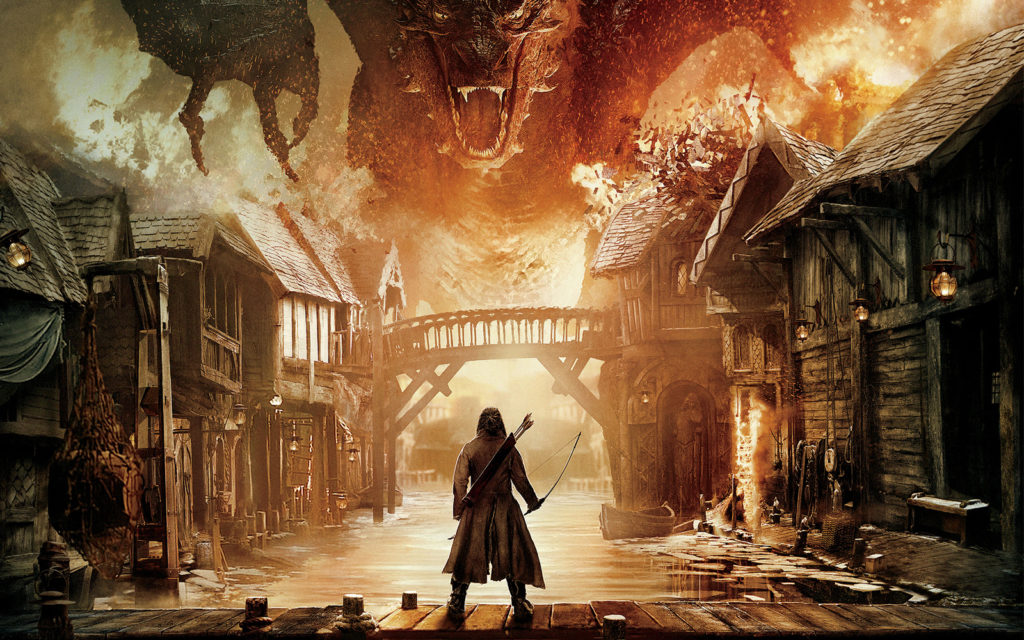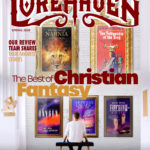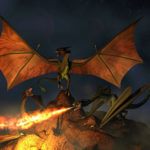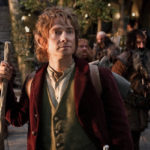Exploring ‘The Hobbit’ Chapter 14: Fire and Water
Here’s another chapter of The Hobbit in which author J.R.R. Tolkien’s original vision, this time for an action/destruction/special-effects sequence, rivals the images of today’s films.
Here I could jinx the thing, but The Hobbit: The Battle of Five Armies would need to try hard to adapt this material poorly. Pretty much any shot of a giant roaring dragon who rains destruction upon the helpless Lake-town will be faithful to the book. You can show burning buildings and docks, explosions, everyone screaming for mercy. Smaug can go all Nazgûl on the place and claw up some hapless horses or residents, then drop them into the carnage.
While I’m making predictions, I think it’s fairly obvious that there will be an overly complex story moment with Bard scrambling up steps, fighting folks, action-hero-rolling across boats, etc., all to get the arrow in place and try to hit the dragon. Wait, sorry, but the film’s version is not a random black arrow though, the kind used by your average Lake-town archer. Instead Peter Jackson Jacksoned the arrow by turning it into a giant super-arrow, more like a harpoon, with its own Legendary Backstory. That’s all a bit overdone, methinks. So will be the film bits that show Bard’s struggles to get the super-arrow in place to shoot.

Five stars if before slaying the beast Bard proclaims,
“Foul wyrm! YOU HAVE FAILED THIS CITY.” (thwip)
And that, come to think of it, already solves one question I had from the book: How will the story sidestep the book’s little bird who whispers about Smaug’s weak spot to Bard? In the film version that whole backstory reminds us that Smaug had one scale knocked loose. So there you go, no more thrush-spy, but I suppose I don’t mind all that much. After all, the films have surprised fans by showing rock-monster mountain-giants and talking spiders.
How do you think The Hobbit: The Battle of the Five Armies will adapt this chapter?
(Note: The following questions were originally written for a local-church reading group.)
Chapter 14: Fire and Water
- This chapter is very What is different about it? What are your reactions?
- Here the tone and even focus of the book changes dramatically, yet only deepening from the foundation already built. What do you see here that already begins to be subversive, that is, deviating from what people may expect, based on similar stories? How may this follow Thorin’s “return of the king” moments when the party arrives at the lake-town?
- “Perhaps the King under the Mountain is forging gold,” said another. (page 233) The men of Esgaroth still expect instant results. They seem to believe in the very “escapist” fairy-tale tropes to which some people compare The Hobbit! How does Tolkien subvert this?
- What themes, if any, could Tolkien be exploring with only the grim-voiced fellow, Bard (pp. 234-235) being right — versus the naïve expectations of his fellow townspeople?
- What do you think about Bard coming from seemingly out of nowhere? How does the author introduce him? Could a modern author (or The Hobbit film version) introduce in this way a figure with a role as significant as this? How do we as readers or film viewers instead expect pivotal characters to be introduced? (Yet another subversion by Tolkien.)
- Unafraid [the thrush] perched by his ear and brought him news. (page 236) When you first read The Hobbit, did you expect the talking thrush and Thorin’s brief history lesson about bird-speech to play a role? How do birds often “play” in fantasy tales like this?
- Another subversion: If you hadn’t read The Hobbit, and someone had told you the basic story beginning, who would you guess would have finally killed Smaug in the end? And would you have thought that would be the end of the story? (Yet Tolkien has the dragon slain with five more chapters left in the book — and more “villains” yet to address!)
- Smaug falls full on the town (page 236). How may this be yet another subversion? What ending would you expect to a story in which any hero, new or known, slays a dragon?
How does Tolkien add realism here to the interactions — and even politics — between the people of Esgaroth, Bard the Bowman, the Master of the lake-down, and finally the arriving Elves? And how may this set apart The Hobbit from other fiction, even fiction supposedly “for children,” or even apart from the first chapters of The Hobbit itself?









































